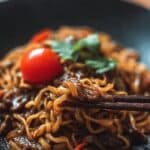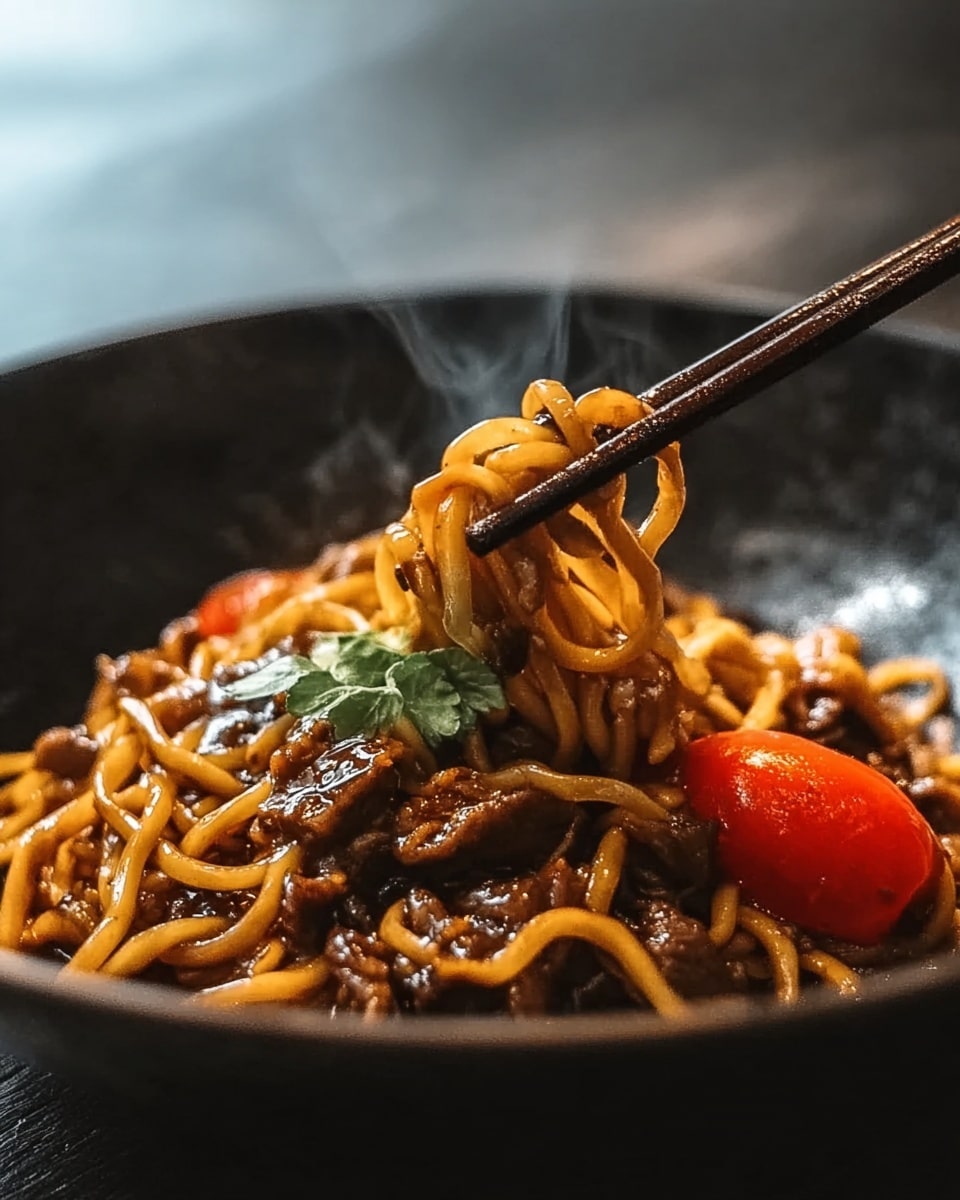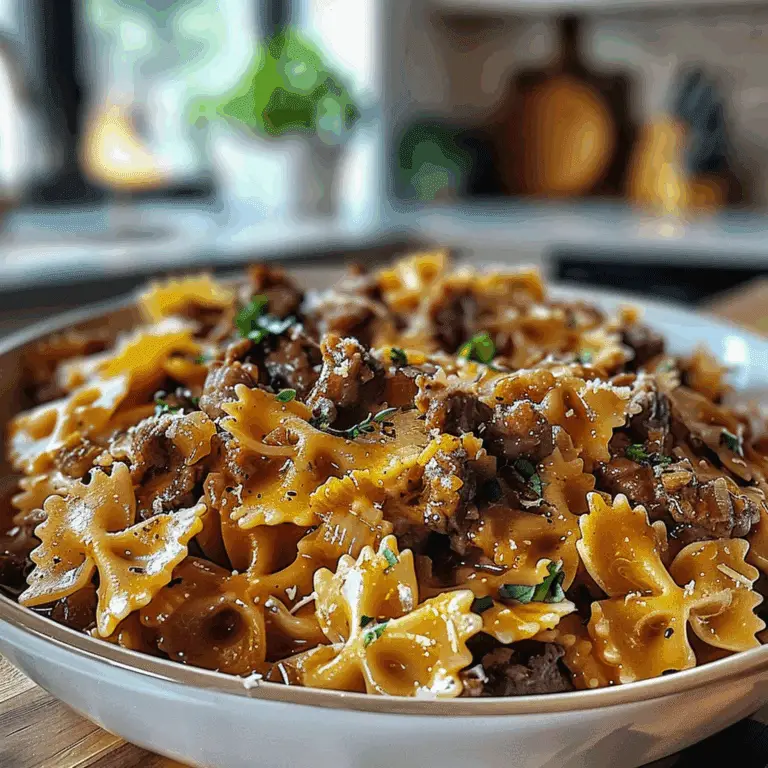Discover the ultimate comfort food with this Yakisoba Noodles Recipe, a beloved Japanese stir-fried noodle dish bursting with vibrant veggies, savory sauce, and your choice of protein. With its harmonious blend of tangy, sweet, and umami flavors, this recipe turns simple ingredients into a satisfying meal that feels like a warm hug on a plate. Whether you’re a noodle lover or a curious home cook, this Yakisoba Noodles Recipe will quickly become a trusted favorite in your kitchen rotation.
Ingredients You’ll Need
Ingredients You’ll Need
Gathering the right ingredients is key to nailing this Yakisoba Noodles Recipe. Each one contributes essential flavors, textures, and colors that bring the dish to life—whether it’s the tender crunch of cabbage or the rich depth of the wok-fried sauce.
- Yakisoba noodles: These slightly chewy wheat noodles are the star, providing the perfect base texture and absorbing the sauce beautifully.
- Worcestershire sauce: Adds tangy complexity and a hint of sweetness that defines the authentic Yakisoba flavor.
- Ketchup: Balances the spice and umami with a touch of tomato-rich sweetness.
- Soy sauce: Brings salty depth and enhances the overall savory notes of the dish.
- Oyster sauce: Delivers a subtle seafood sweetness and umami richness, elevating the stir-fry.
- Sugar: Just a pinch to harmonize the sour and salty components in the sauce.
- Vegetables: Onions, carrots, bell peppers, cabbage, and mushrooms provide fresh crunch, sweetness, and earthiness for a well-rounded dish.
- Protein (optional): Chicken, pork, shrimp, or tofu that adds heartiness and pairs perfectly with the noodles.
- Oil for frying: Neutral oils like vegetable or canola are great for stir-frying without overpowering the flavors.
- Garnishes: Green onions, sesame seeds, and pickled red ginger give that final authentic touch and delightful texture contrast.
How to Make Yakisoba Noodles Recipe
Step 1: Make the Sauce
Start by whisking together Worcestershire sauce, ketchup, soy sauce, oyster sauce, and sugar in a small bowl until smooth. This sauce is the heart of your Yakisoba, balancing tangy, sweet, and savory flavors that glaze every ingredient wonderfully.
Step 2: Prep the Noodles
If you have fresh Yakisoba noodles, loosen them gently under warm running water to separate strands. If fresh ones aren’t available, instant noodles work well—just cook them according to package instructions without seasoning, then drain thoroughly to avoid sogginess.
Step 3: Cook the Protein
Heat a tablespoon of oil in a large skillet or wok over medium-high heat. Add your chosen protein and cook it until browned and fully cooked through. Set the protein aside temporarily—this keeps it juicy and ready to combine later without overcooking.
Step 4: Sauté the Vegetables
In the same pan, add more oil if needed, then toss in the onions, carrots, and bell peppers. Stir-fry for about 2 to 3 minutes to soften them just enough while retaining freshness. Next, add cabbage and mushrooms and continue cooking for another 2 minutes to achieve the ideal tender-crisp texture.
Step 5: Add the Noodles and Sauce
Return the protein to the pan, add the prepared noodles, then pour your homemade sauce over the top. Toss everything together thoroughly, stir-frying for 2 to 3 minutes so the noodles are heated through and perfectly coated with that luscious sauce.
Step 6: Garnish and Serve
Serve your Yakisoba hot, topped with fresh green onions, crunchy sesame seeds, and if you like, a pop of color and zest from pickled red ginger. These garnishes elevate taste and visual appeal, finishing this dish just right.
How to Serve Yakisoba Noodles Recipe
Garnishes
Garnishing makes the dish pop visually and adds fresh, vibrant flavor notes. Green onions lend a mild sharpness, toasted sesame seeds contribute nutty crunch, and pickled red ginger brings a tangy brightness that cuts through the richness of the sauce. Don’t skip these—they truly complete the experience.
Side Dishes
Yakisoba noodles pair wonderfully with light sides like a crisp cucumber salad, steamed edamame, or miso soup. These simple accompaniments balance the richness of the noodles while maintaining an authentic Japanese-inspired meal.
Creative Ways to Present
Try serving Yakisoba in a colorful bowl topped with a fried egg for extra indulgence or wrapped in lettuce leaves for a delightful handheld option. Adding crushed peanuts or chili flakes can introduce exciting textures and spice, turning this humble noodle dish into a showstopper.
Make Ahead and Storage
Storing Leftovers
Store leftover Yakisoba in an airtight container in the refrigerator for up to 3 days. The noodles may absorb more sauce and become softer, but reheating with a splash of water or oil helps refresh their texture.
Freezing
While freezing is possible, the texture of the noodles can change and become mushy once thawed. If you do freeze, separate portions in freezer-safe containers and try to reheat gently, preferably in a skillet rather than a microwave.
Reheating
Reheat Yakisoba in a hot skillet with a drizzle of oil to bring back that freshly stir-fried flavor and to avoid sogginess. Stir frequently until warmed through. Alternatively, a quick microwave session covered loosely with a damp paper towel works in a pinch.
FAQs
Can I use other noodles instead of Yakisoba noodles?
Absolutely! While Yakisoba noodles are traditional and ideal due to their texture, you can substitute with ramen, udon, or even spaghetti. Just keep in mind cooking times and textures may vary slightly.
Is this Yakisoba Noodles Recipe suitable for vegetarians?
Yes! Simply omit the meat protein and use tofu or extra mushrooms instead. Also, check that your oyster sauce is vegetarian, or substitute it with a mushroom-based sauce alternative.
How spicy is this Yakisoba Noodles Recipe?
The recipe as written is mild and tangy. Feel free to add chili flakes, sliced fresh chilies, or a splash of hot sauce if you love a bit of heat in your noodles.
Can I prepare this dish ahead of time?
You can prep the sauce and chop vegetables ahead, but it’s best to cook and combine everything fresh to preserve texture and flavor. Leftovers reheat well, so planning ahead is always an option!
What protein works best with Yakisoba noodles?
Chicken, pork, and shrimp are classic choices that complement the flavors beautifully. However, beef, tofu, or even a fried egg on top are fantastic alternatives that can customize this dish to your liking.
Final Thoughts
If you’re craving something both comforting and bursting with vibrant flavors, this Yakisoba Noodles Recipe fits the bill perfectly. Easy to make, endlessly adaptable, and downright delicious, it’s the kind of dish you’ll want to come back to time and again. Give it a try and watch how quickly it becomes one of your go-to meals for busy weeknights or casual gatherings with friends.
Print
Yakisoba Noodles Recipe
- Prep Time: 10 minutes
- Cook Time: 15 minutes
- Total Time: 25 minutes
- Yield: 2 to 3 servings
- Category: Main Dish
- Method: Stovetop
- Cuisine: Japanese
- Diet: Halal
Description
This Yakisoba Noodles recipe is a quick and flavorful Japanese stir-fry dish featuring tender noodles, mixed vegetables, and your choice of protein, all tossed in a savory homemade sauce made from Worcestershire sauce, ketchup, soy sauce, and oyster sauce. Perfect for a satisfying weeknight meal, it combines a delicious balance of sweet, tangy, and umami flavors with a pleasing mix of textures.
Ingredients
Sauce
- 2 tablespoons Worcestershire sauce
- 1 tablespoon ketchup
- 1 tablespoon soy sauce
- 1 tablespoon oyster sauce
- 1 teaspoon sugar
Noodles
- 200 grams fresh yakisoba noodles (or instant noodles without seasoning)
Protein (optional)
- 150 grams protein of choice (chicken, pork, tofu, or shrimp)
- 1 tablespoon vegetable oil (for cooking protein)
Vegetables
- 1/2 cup sliced onions
- 1/2 cup thinly sliced carrots
- 1/2 cup sliced bell peppers (any color)
- 1 cup chopped cabbage
- 1/2 cup sliced mushrooms
- Additional vegetable oil as needed for stir-frying
Garnishes (optional)
- Chopped green onions
- 1 tablespoon sesame seeds
- Pickled red ginger (beni shoga)
Instructions
- Make the sauce: In a small bowl, whisk together Worcestershire sauce, ketchup, soy sauce, oyster sauce, and sugar until smooth. Set this flavorful sauce aside for later use.
- Prep the noodles: If using fresh yakisoba noodles, loosen them gently under warm running water to separate the strands, then set aside. For instant noodles, cook according to package instructions without using the seasoning packets, then drain well.
- Cook the protein (if using): Heat 1 tablespoon of vegetable oil in a large skillet or wok over medium-high heat. Add your choice of protein and cook until browned all over and fully cooked through. Remove from the pan and set aside to keep warm.
- Sauté the vegetables: In the same skillet or wok, add a little more oil if needed to prevent sticking. Stir-fry the onions, carrots, and bell peppers for 2 to 3 minutes until they begin to soften. Add the cabbage and mushrooms and continue stir-frying for another 2 minutes until all vegetables are just tender but still crisp.
- Add the noodles and sauce: Return the cooked protein to the pan. Add the prepared noodles and pour the sauce over all the ingredients. Toss everything thoroughly to coat evenly with the sauce, then stir-fry for an additional 2 to 3 minutes until the noodles are heated through and infused with the sauce flavors.
- Garnish and serve: Serve the yakisoba hot, garnished with chopped green onions, a sprinkle of sesame seeds, and pickled red ginger for a traditional touch and extra zing.
Notes
- To make this dish vegetarian, omit the oyster sauce or substitute it with mushroom sauce and use tofu as the protein.
- Fresh yakisoba noodles yield the best texture, but instant noodles are a convenient alternative.
- Feel free to customize the vegetables according to your preference or availability; bean sprouts and snap peas also work well.
- Adjust the sauce quantities depending on how saucy you like your noodles.
- Leftovers can be stored in an airtight container in the refrigerator for up to 2 days and reheated in a skillet.









